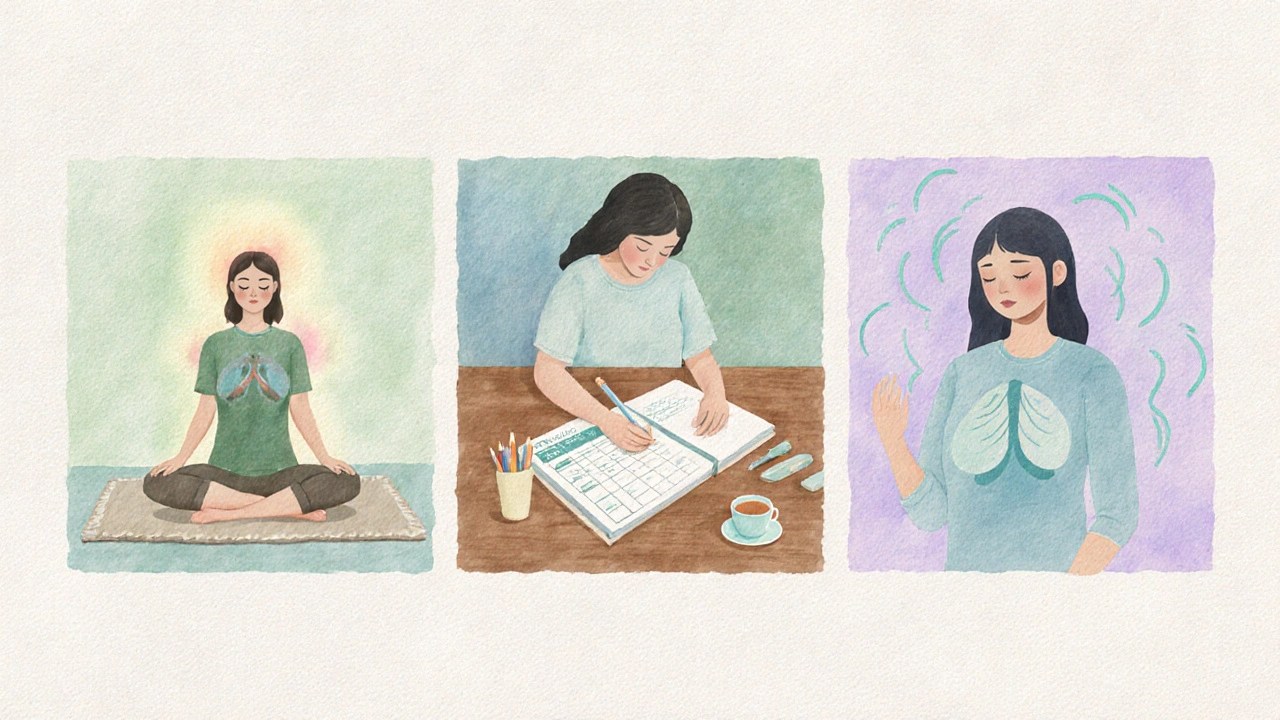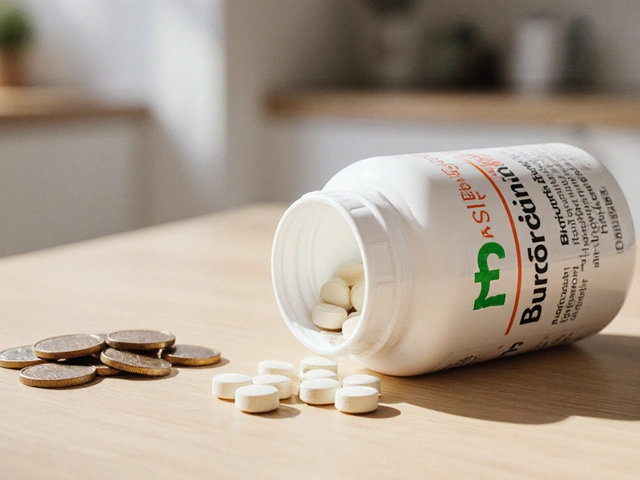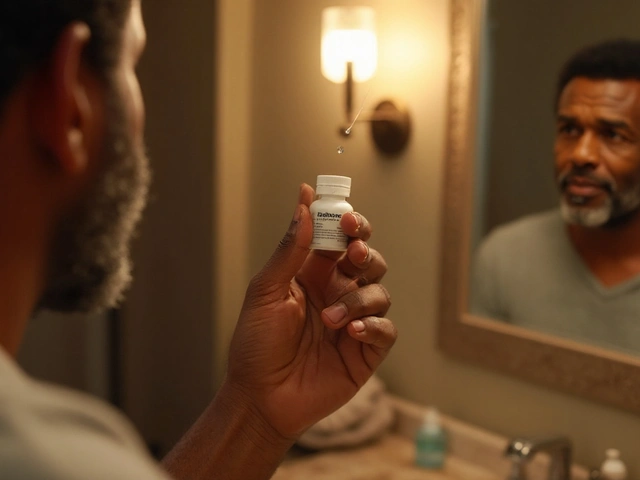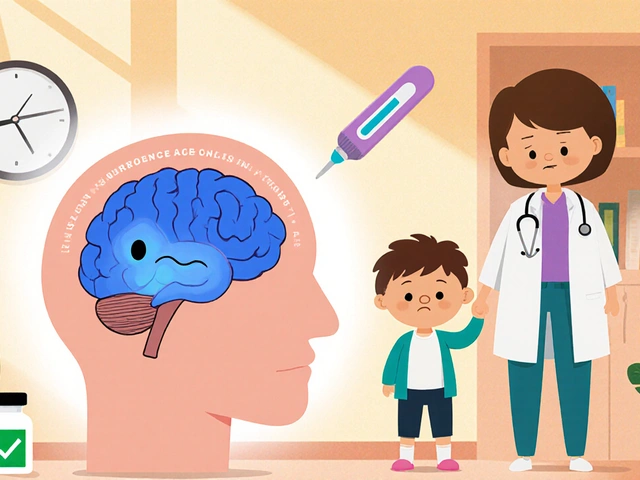Endometriosis Emotional Impact Calculator
Your Emotional Impact Assessment
Recommended Coping Strategies Based on Your Score
Your personalized coping strategy recommendations will appear here after calculating your score.
Endometriosis is a chronic, estrogen‑dependent condition where tissue similar to the uterine lining grows outside the uterus, causing pain, infertility, and a host of emotional challenges. While the physical symptoms dominate medical discussions, the emotional toll-anxiety, depression, and feelings of isolation-often goes unaddressed. This guide walks you through how the condition affects mood, why those feelings are valid, and practical ways to reclaim emotional well‑being.
Why Endometriosis Triggers Strong Emotional Reactions
The body‑mind link means that persistent pelvic pain, heavy periods, and unpredictable flare‑ups can fuel uncertainty and fear. Research from the British Endometriosis Society (2024) shows that 57% of diagnosed women report moderate‑to‑severe anxiety, while 45% experience depressive symptoms. Hormonal fluctuations, chronic fatigue, and the social stigma of “invisible” pain all pile on, creating a perfect storm for emotional distress.
Two key mechanisms drive this impact:
- Physiological stress response: Chronic pain raises cortisol levels, which can impair serotonin production, directly influencing mood.
- Psychosocial stressors: Missed work, strained relationships, and concerns about fertility add layers of pressure that can erode self‑esteem.
Understanding these pathways helps you see that emotional upset isn’t “just in your head” - it’s a real, biologically‑rooted response.
Core Coping Strategies You Can Start Using Today
Below are evidence‑based tactics that target both the mind and the body. Pick the ones that feel doable and blend them into a personalized routine.
- Mindful Body Scanning - Spend 5‑10 minutes each morning checking in with each body part. Acknowledge sensations without judgment. This simple practice has been shown to reduce pain‑related anxiety by up to 30% in a 2023 pilot study.
- Scheduled “Pain‑Free” Activities - Block out times for hobbies you love, even if they’re brief. Consistent engagement can boost dopamine, counteracting the low‑mood cycle.
- Journal Your Symptoms - Logging pain intensity, menstrual flow, and mood helps you spot patterns. Over time, you may discover triggers (e.g., stress, certain foods) that you can avoid.
- Therapeutic Breathing - The 4‑7‑8 technique (inhale 4seconds, hold 7, exhale 8) lowers heart rate and can calm the sympathetic nervous system during flare‑ups.
- Professional Counseling - Seeing a therapist familiar with chronic illness, especially those using Cognitive Behavioral Therapy (CBT), can re‑wire negative thought loops. CBT has a 60% remission rate for depression linked to chronic pain.
These steps form a toolbox; you don’t need to use them all at once. Start with one or two, and expand as you feel more confident.

When Medical Treatment Meets Emotional Care
Medication can ease the physical burden, but it also influences mood. Below is a quick comparison of common medical options and their emotional side‑effects.
| Treatment | Primary Physical Benefit | Typical Emotional Side‑Effect | Best Complementary Coping Tool |
|---|---|---|---|
| Hormone Therapy (e.g., GnRH agonists) | Reduces lesion growth, pain | Possible mood swings, hot flashes | Therapeutic Breathing + CBT |
| NSAIDs (Ibuprofen, Naproxen) | Short‑term pain relief | Rare GI upset, occasional irritability | Mindful Body Scanning |
| Laparoscopic Excision | Long‑term pain reduction | Post‑surgical anxiety, recovery fatigue | Scheduled “Pain‑Free” Activities |
| Botanical Supplements (e.g., Curcumin) | Anti‑inflammatory effect | Minimal, but monitor for interactions | Journal Your Symptoms |
Pairing any medical approach with a supportive emotional practice maximizes overall quality of life.
Building a Support Network That Actually Helps
Isolation is a common complaint; talking to people who “don’t get it” can feel superficial. Here’s how to find genuine support:
- Local Support Groups - In the UK, the Endometriosis UK charity hosts monthly meet‑ups in cities like Bristol, Manchester, and London. Face‑to‑face sharing offers validation and practical tips.
- Online Communities - Platforms such as Reddit (r/Endometriosis) and Facebook groups provide 24/7 access to peers. Look for “moderated” groups to avoid misinformation.
- Professional Peer Programs - Some hospitals run “patient navigator” services where a trained volunteer with lived experience helps you manage appointments and emotional hurdles.
- Family Education - Share concise fact sheets (e.g., a one‑page infographic) with loved ones so they understand flare‑up triggers and can offer concrete assistance, like preparing meals during heavy days.
Remember, a network is only as strong as the communication within it. Set boundaries, be clear about the support you need, and don’t hesitate to step back if a particular group feels draining.

Special Considerations: Fertility Concerns and Identity
For many, endometriosis raises worries about future family planning. The emotional weight can be massive, especially when fertility treatments are suggested. Here are three ways to manage those feelings:
- Early Consultation - Speak with a reproductive endocrinologist as soon as you’re diagnosed. Knowing your ovarian reserve and treatment options early reduces the shock factor.
- Therapeutic Narrative - Reframe your story from “loss” to “resilience.” Many women find purpose in advocacy, research participation, or mentorship, which can restore a sense of agency.
- Mind‑Body Fertility Programs - Some clinics integrate acupuncture, yoga, and guided imagery to improve uterine blood flow while also soothing anxiety. The dual benefit is backed by a 2022 meta‑analysis linking mindfulness‑based fertility programs to higher pregnancy rates.
Addressing fertility openly with your partner or support circle can prevent the buildup of secret grief that fuels depression.
Quick Checklist for Daily Emotional Maintenance
- Morning body‑scan (5min)
- Log pain & mood in a journal
- Practice 4‑7‑8 breathing during flare‑up
- Schedule one enjoyable activity
- Connect with a support person or group
- Take any prescribed medication with food, monitor side‑effects
- Review upcoming appointments; ask one question in advance
Checking these items off each day creates a rhythm that can buffer the emotional highs and lows.
Frequently Asked Questions
Can endometriosis cause depression?
Yes. Chronic pelvic pain, hormonal changes, and the stress of managing a long‑term condition all raise the risk of depression. Studies in 2023 found that women with endometriosis are 1.5times more likely to be diagnosed with major depressive disorder compared to those without the condition.
Is it safe to use CBT if I’m on hormone therapy?
CBT focuses on thought patterns and coping skills; it does not interact with medications. In fact, combining CBT with hormone therapy often improves both pain perception and mood, making it a recommended complementary approach.
How can I talk to my partner about the emotional toll?
Pick a calm moment, use “I‑feel” statements, and share specific examples (e.g., “I feel overwhelmed when the pain spikes at night”). Offer concrete ways they can help, such as assisting with chores or simply listening without trying to fix the pain.
Are online support groups reliable?
Many are valuable, but quality varies. Look for groups moderated by healthcare professionals or reputable charities. Verify any medical advice with your clinician before acting on it.
What lifestyle changes help reduce emotional stress?
Regular low‑impact exercise (walking, swimming), balanced anti‑inflammatory diet, consistent sleep schedule, and limiting caffeine/alcohol can all lower cortisol levels, which in turn eases anxiety and mood swings.






7 Comments
I hear you; it’s tough, but you’re not alone.
Wow, this guide really hits the nail on the head!
Living with endometriosis can feel like an emotional roller‑coaster, but having tools to track your feelings is a game‑changer.
Remember, every little self‑care habit you build adds up – even a five‑minute breathing break counts.
Lean on supportive communities, share your scores, and celebrate the wins, no matter how small.
You’ve got the strength to navigate this, and we’re all cheering you on!
It is astonishing how frequently laypeople conflate emotional turbulence with a lack of personal resilience, as if the mere presence of a chronic gynecological condition necessitates a deficit in character.
One must first acknowledge the extensive body of scholarly literature that delineates the neuroendocrine pathways implicated in endometriosis‑related mood disturbances.
Neglecting such data in favor of anecdotal platitudes does a disservice to both the patient and the clinician.
The emotional impact calculator presented here, while rudimentary, is a commendable attempt to quantify subjective experience.
However, its binary scaling obscurely reduces nuanced affective states to simplistic numeric values, betraying a reductionist bias.
Moreover, the suggested coping strategies are curiously generic, lacking the specificity that evidence‑based interventions demand.
One would expect a reference to cognitive‑behavioral therapy modules, mindfulness‑based stress reduction, or even pharmacologic adjuncts where appropriate.
Instead, the guide offers vague encouragement, which, while well‑intentioned, borders on the platitudinous.
Patients deserve a more sophisticated framework that integrates psychosocial assessment with individualized treatment planning.
In practice, multidisciplinary clinics that embed mental health specialists alongside surgeons provide the gold standard of care.
Future iterations of this tool might incorporate dynamic feedback loops, allowing users to track longitudinal changes in mood and functional capacity.
It is also incumbent upon developers to consider cultural determinants that shape emotional expression, lest the tool be inadvertently ethnocentric.
Finally, the interface could benefit from an aesthetic overhaul; the current design appears as though it were cobbled together in a hastily assembled prototype.
Nevertheless, the initiative to foreground emotional wellbeing is laudable, and with iterative refinement, this calculator could evolve into a genuinely valuable resource.
Until such enhancements are realized, clinicians and patients alike should employ this instrument with a critical, yet compassionate, lens.
Honestly, the language in this guide is pretty solid, but there’s a tiny slip that caught my eye.
In the phrase “Your personalized coping strategy recommendations will appear here,” the verb “appear” should agree with the plural “recommendations,” so it’s technically correct, yet many readers gloss over such nuances.
It’s a small thing, but paying attention to grammar reflects the care we put into managing our health.
Well, if we’re going to talk about emotional impact, let’s not forget the sheer melodrama that often surrounds chronic illness narratives.
It’s almost theatrical how some people turn every symptom into a tragic monologue, while others sip their tea and pretend everything’s fine.
Either way, the calculator offers a stage for those feelings – a spotlight, if you will.
Just remember, the drama ends when you take actionable steps.
The tool’s algorithm appears to assign equal weight to each questionnaire item, which aligns with standard psychometric practices for balanced scales.
Nevertheless, a weighted model might capture differential impacts more accurately, especially if empirical validation supports such adjustments.
Including a brief methodological note would enhance transparency for users interested in the underlying calculations.
Absolutely, feeling isolated is a common thread, and it’s crucial to validate those emotions.
At the same time, remember that reaching out to peer support groups can turn solitude into solidarity – no need to suffer in silence.
It’s ironic how often we expect instant relief, yet real progress comes from consistent, small efforts.